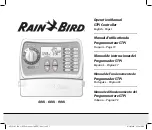
Beta Draft Confidential
Configuring SPVCs
Defining a Point-to-Point Offnet Circuit Connection
ATM Services Configuration Guide for CBX 3500, CBX 500, GX 550, and B-STDX 9000
1/19/05
18-13
Endpoint 2
Connection ID
Destination Service Type – Choose the ATM button or Frame Relay
button, depending on the service on the destination endpoint.
Target Select Type – Choose Any or Required from the pull-down list.
Any indicates that the terminating endpoint uses any available VPI/VCI
value. If you need to specify a VPI/VCI for the terminating endpoint,
you must complete the PVC/PVP Termination fields on the Add SVC
Port Address dialog box.
Required indicates that the terminating endpoint uses the VPI/VCI
address you specify. If this is an SPVPC, enter the VPI; for an SPVCC,
enter the VPI and VCI.
VPI – If Required is selected for the Target Select Type, enter a unique
virtual path identifier (VPI) value ranging from 0 to 15.
VCI – If Required is selected for the Target Select Type, enter a unique
virtual channel identifier (VCI) value ranging from 32 to 255.
DLCI (16-991) – If applicable, displays the DLCI, a 10-bit address that
identifies PVCs. The DLCIs identify the logical end points of a VC and
only have local significance.
Management
Circuit
Select the Management Circuit check box to include this configuration
in the NMS initialization script file. This file contains all the SNMP set
requests necessary to replicate the entire switch configuration. Once you
download this file to the switch, this circuit can be used to establish
NMS-to-switch connectivity. This option is especially useful in some
management DLCI configurations. The default value is a clear check
box.
Is Template
(Optional) Select this check box if you want to use this offnet circuit as a
template to create other circuits using similar parameters.
Admin Cost
Threshold
Not applicable for offnet circuits.
End-End Delay
Threshold
Not applicable for offnet circuits.
Resource
Partitioning:
Network
Overflow
Determines how offnet circuit traffic is managed during trunk overflow
or failure conditions. This feature is used with Virtual Private Networks
(VPNs). For more information about VPNs, see
Choose one of the following buttons:
Public – (default) Offnet circuits are routed over dedicated VPN trunks.
However, in the event of failure, the customer’s traffic is allowed to run
over common trunks (shared by a variety of different customers).
Restricted – Offnet circuits can only use dedicated VPN trunks. A
customer using this mode must purchase redundancy trunks to be used in
the event of outages or other trunk failures.
Table 18-4.
Add OffNet Circuits: Administrative Tab Fields (Continued)
Field
Action/Description
Содержание CBX 3500
Страница 888: ......
















































